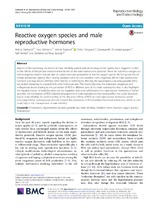| dc.contributor.author | Darbandi, Mahsa | |
| dc.contributor.author | Darbandi, Sara | |
| dc.contributor.author | Agarwal, Ashok | |
| dc.contributor.author | Sengupta, Pallav | |
| dc.contributor.author | Durairajanayagam, Damayanthi | |
| dc.contributor.author | Henkel, Ralf | |
| dc.contributor.author | Sadeghi, Mohammad Reza | |
| dc.date.accessioned | 2018-09-17T06:55:47Z | |
| dc.date.available | 2018-09-17T06:55:47Z | |
| dc.date.issued | 2018 | |
| dc.identifier.citation | Darbandi, M. et al. (2018). Reactive oxygen species and male reproductive hormones. Reproductive Biology and Endocrinology, 16: 87 | en_US |
| dc.identifier.issn | 1477-7827 | |
| dc.identifier.uri | https://doi.org/10.1186/s12958-018-0406-2 | |
| dc.identifier.uri | http://hdl.handle.net/10566/4042 | |
| dc.description.abstract | Reports of the increasing incidence of male infertility paired with decreasing semen quality have triggered studies
on the effects of lifestyle and environmental factors on the male reproductive potential. There are numerous exogenous
and endogenous factors that are able to induce excessive production of reactive oxygen species (ROS) beyond that of
cellular antioxidant capacity, thus causing oxidative stress. In turn, oxidative stress negatively affects male reproductive
functions and may induce infertility either directly or indirectly by affecting the hypothalamus-pituitary-gonadal (HPG)
axis and/or disrupting its crosstalk with other hormonal axes. This review discusses the important exogenous and
endogenous factors leading to the generation of ROS in different parts of the male reproductive tract. It also highlights
the negative impact of oxidative stress on the regulation and cross-talk between the reproductive hormones. It further
describes the mechanism of ROS-induced derangement of male reproductive hormonal profiles that could ultimately
lead to male infertility. An understanding of the disruptive effects of ROS on male reproductive hormones would
encourage further investigations directed towards the prevention of ROS-mediated hormonal imbalances, which in turn
could help in the management of male infertility. | en_US |
| dc.language.iso | en | en_US |
| dc.publisher | BMC | en_US |
| dc.rights | © The Author(s). 2018 Open Access This article is distributed under the terms of the Creative Commons Attribution 4.0
International License (http://creativecommons.org/licenses/by/4.0/), which permits unrestricted use, distribution, and
reproduction in any medium, provided you give appropriate credit to the original author(s) and the source, provide a link to
the Creative Commons license, and indicate if changes were made. The Creative Commons Public Domain Dedication waiver
(http://creativecommons.org/publicdomain/zero/1.0/) applies to the data made available in this article, unless otherwise stated. | |
| dc.subject | Antioxidants | en_US |
| dc.subject | Hypothalamic-pituitary-gonadal axis | en_US |
| dc.subject | Male infertility | en_US |
| dc.subject | Oxidative stress | en_US |
| dc.subject | Reactive oxygen species | en_US |
| dc.subject | Testosterone | en_US |
| dc.title | Reactive oxygen species and male reproductive hormones | en_US |
| dc.type | Article | en_US |
| dc.privacy.showsubmitter | FALSE | |
| dc.status.ispeerreviewed | TRUE | |

